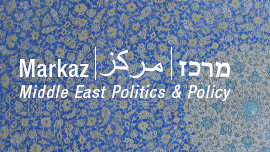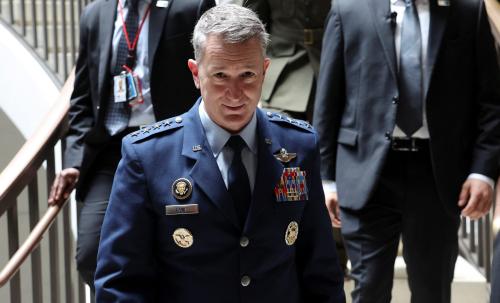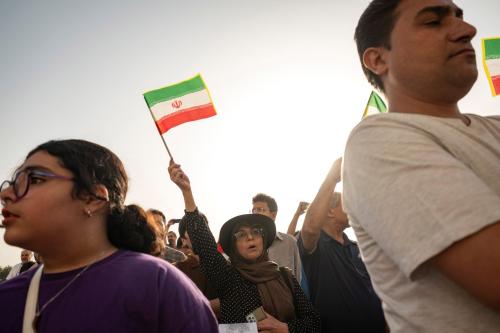As another round of nuclear negotiations between Iran and six world powers gets underway on the sidelines of the United Nations General Assembly meetings in New York, a variety of other issues – including the U.S. military presence in the region, energy security, and non-state actors such as the Islamic State – complicate regional dynamics. Several past and present Brookings scholars spoke on these issues at events held last week in Washington.
At a Woodrow Wilson International Center discussion on Iran’s regional role on September 17, Ambassador Thomas Pickering, a Brookings Distinguished Fellow, launched a report entitled “Iran and Its Neighbors: Regional Implications for U.S. Policy of a Nuclear Agreement.” Pickering argued that, regardless of whether a nuclear agreement is reached, the United States should maintain its current regional posture. Georgetown University professor Paul R. Pillar, a non-resident senior fellow with the Brookings Center for 21st Century Security and Intelligence, contended that Washington and Tehran share an interest in eliminating the militant group that calls itself the Islamic State (also known as ISIS). He argued that Iraq could serve as an arena for communication and coordination between the two countries, though he and Pickering emphasized that this would have no bearing on the nuclear negotiations.
A second WWIC event focused on previous cases of successful nuclear negotiations. WWIC senior associate Michael Kugelman stressed the importance of analyzing successful negotiations – such as the U.S.-India talks on their civil nuclear accord – to glean methods that may help the Iranian and P5+1 negotiating teams overcome such obstacles.
Dinshaw Mistry, author of The U.S.-India Nuclear Agreement: Diplomacy and Domestic Politics and a former Brookings staffer, noted that the U.S.-India talks succeeded only at the last minute, via technical solutions which bridged major gaps. Ultimately, the Bush administration agreed to split the difference on issues including the number of reactors under safeguards, the moratorium on testing, right of return, the permanence of safeguards, and fuel supply assurances.
Mistry identified three factors that made non-proliferation concessions palatable to Washington, including broader foreign policy issues. First, China’s rise elevated India’s importance as a potential ally, and a nuclear agreement promised to reinforce strategic ties. The second factor was bureaucratic positions; U.S. negotiators included regional specialists, not just non-proliferation experts, and Mistry believes that this helped drive U.S. concessions on some nuclear issues. Finally, legislative politics played a role, as Congress ultimately supported the agreement due to the Bush Administration’s energetic outreach as well as lobbying by American business, Indian-American groups, and the Indian government.
Mistry noted that, once approved by Congress, the agreement faced hurdles in India. Its progress was slowed by bureaucratic squabbling and domestic politics, and it only passed after a year of government lobbying. According to Mistry, the Indian case shows that political factors are as important, or more important, than technical details in formulating nuclear deals.
Stimson Center co-founder Michael Krepon agreed, and offered five criteria for a successful deal: first, it must reduce nuclear dangers; second, it should balance against a common adversary; third, it should forge new understanding between the two parties; fourth, it should make money, ideally through domestic job creation; and fifth, it should be politically popular at home.
Robert Litwak, the Woodrow Wilson Center’s vice president for scholars, suggested that Washington has earnestly pursued its stated commitment to non-proliferation only against hostile proliferators. This “rogue state” approach complicated U.S. engagement with Iran and North Korea until Obama recast the U.S. stance, a shift that Litwak believes, coupled with sanctions, brought Iran to the table. According to Litwak, the current P5+1 position – barring weaponization, but not eliminating enrichment – allows Iran a limited hedge and makes a deal possible. But he maintained that politics may still play spoiler, so the Iranian leadership must decide if the economic benefits of sanctions relief outweigh the costs of alienating hardliners.
Joel Wit, a visiting fellow at Johns Hopkins University’s U.S.-Korea Institute and a former Brookings visiting fellow, asserted that, if a deal is passed, the U.S. must learn from the example of its 1994 Agreed Framework with North Korea, which was undermined by the Washington’s failure to adequately develop broader political, diplomatic and economic relations with the DPRK. Wit emphasized that if an agreement with Iran is reached and non-nuclear issues go unaddressed, those issues will ultimately lead to the collapse of the nuclear element.
Kugelman closed with a summary of the afternoon’s events: what are the steps to negotiating an enduring nuclear agreement? It’s complicated.
The Brookings Institution is committed to quality, independence, and impact.
We are supported by a diverse array of funders. In line with our values and policies, each Brookings publication represents the sole views of its author(s).




Commentary
Brookings Affiliates Discuss Iran’s Regional Role and Precedents for a Nuclear Deal
September 24, 2014